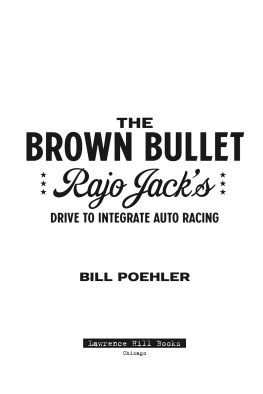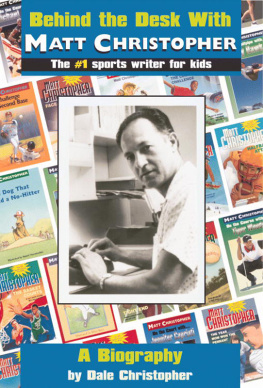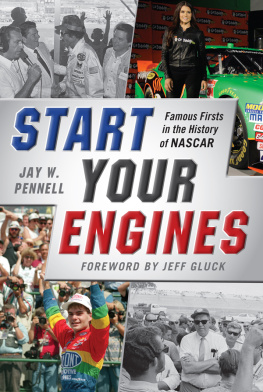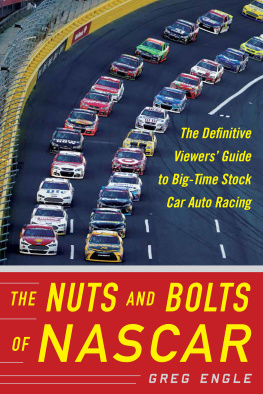Copyright 2011 by Matt Christopher Royalties, Inc.
All rights reserved. Except as permitted under the U.S. Copyright Act of 1976, no part of this publication may be reproduced, distributed, or transmitted in any form or by any means, or stored in a database or retrieval system, without the prior written permission of the publisher.
Little, Brown and Company
Hachette Book Group
237 Park Avenue, New York, NY 10017
Visit our website at www.HachetteBookGroup.com
www.lb-kids.com
Little, Brown and Company is a division of Hachette Book Group, Inc.
The Little, Brown name and logo are trademarks of Hachette Book Group, Inc.
The publisher is not responsible for websites (or their content) that are not owned by the publisher.
First eBook Edition: May 2011
Matt Christopher is a registered trademark of Matt Christopher Royalties, Inc.
Text written by Stephanie True Peters
ISBN: 978-0-316-17510-4
Have you ever dreamed of driving a car that can go more than two hundred miles per hour? If so, then you might be the next champion car racer. But what kind of car do you imagine yourself driving: open-wheeled or stock? Do you know the differences?
Open-wheeled race cars look very different from everyday cars. The wheels are set alongside the body of the car rather than below and are not covered by fenders. The chassis (the cars framework and body) rides low and has front and rear wings to help the car hug the pavement. These single-seaters offer little cover above the driver.
In the United States, these racers are called Indy cars. They get their name from the most famous race they enterthe Indianapolis 500. Every Memorial Day weekend, hundreds of thousands of fans flock to the Indianapolis Motor Speedway in Indiana to watch the best Indy car drivers test their skills on the oval course.
Unlike Indy cars, stock cars look like regular cars. Thats the only regular thing about them! These racers are made to take the beating of hundreds of fast-paced miles. Their engines are superpowered, and their chassis are built to minimize drag and maximize safety. Even the tires are differenttheyre filled with nitrogen, not air, so that they wont explode as they heat up on the track.
Stock car events in the United States are run by the National Association for Stock Car Auto Racing, or NASCAR. The highlight of NASCARs year is the Daytona 500. Like its cousin in Indianapolis, the Daytona 500 attracts the finest drivers of its sport and fills the stands of the Daytona International Speedway with countless cheering fans.
These two races share many similarities. Theyre the same distance: 500 miles, or 200 laps. The Indy 500 is also known as The Greatest Spectacle in Racing. The Daytona is called The Great American Race. Each holds qualifying laps to determine which driver gets the best starting position, called the pole. Both races use a system of colored and patterned flags to tell the drivers when to go, slow down, or stop and when the race has been won. The races both start with a pace car leading the field once around the track so that the drivers can begin from a rolling, rather than a standing, start.
But not much else about these two events is the same. Thirty-three cars participate in the Indy 500; 43 race in the Daytona 500. The Indy 500 takes place on Memorial Day every May; leading up to the race is Festival 500, a month of activities that celebrate cars and past races. The Daytona 500 is in mid-February after Speed Weeks, a two-week-long NASCAR extravaganza that includes sports cars and truck racing plus two days of qualifiers. Daytona drivers are typically from the United States, while the field of Indy drivers is more international.
Now, maybe you already count yourself as a fan of car racing. But if you want to know even more about the most exciting moments of the Indianapolis 500 and the Daytona 500, then put on your seat belt, rev your engineand speed into the pages of this book!
Carl Fisher, owner of a car headlight company, had an idea. He wanted people to come to his home-town, Indianapolis, Indiana, to buy cars. If they did, then hed sell more headlights.
But how could he get people to come? That was the big question.
The answer, Fisher believed, lay in car racing. Car racing had been around almost as long as cars themselves. The first gasoline-powered car was built sometime between 1885 and 1886 by German manufacturer Karl Friedrich Benz. The first race took place on June 22, 1894, when 21 cars drove for first place from Paris to Rouen in France. A year later, the United States held its first race, a round-trip journey in Illinois from Chicago to Evanston and back.
Hundreds of car enthusiasts followed these and later events closely, either in person or through newspaper accounts. By the early 1900s, car racing had become a very popular sport, generating huge crowds of rabid fans. Fisher wanted to bring that fan base to Indianapolis. So in 1904, he decided to build a state-of-the-art racetrack there.
The Indianapolis Motor Speedway, a two-and-a-half-mile oval with four banked corners and a surface of tar covered with crushed stone, opened three years later. On August 19, 1909, the track held one of its first events, a 300-mile race.
It was a disaster.
As the race progressed, the track disintegrated. The asphalt melted under the hot sun. The crushed-stone surface became unstable. One car skidded off the track and flipped, killing the driver and his riding mechanic. Another mechanic and two spectators died later when a blown tire sent a car lunging into the stands. When yet another accident occurred, officials canceled the remaining laps and closed the track.
Fisher knew he had to do something to save his Speedway. Since the surface was the problem, he repaved the oval with 3.2 million bricks.
The Brickyard, as the Speedway was now nicknamed, held three small events in 1910. In 1911, Fisher focused on one spectacular 500-mile race. The distance was determined by the number of hours (seven) he guessed spectators would watch cars race multiplied by the cars top speed (seventy-five miles per hour). He chose May 30, Memorial Day, for the first Indianapolis 500-Mile International Sweepstakes.
Forty drivers entered the event. One was Ray Harroun, who sat behind the wheel of the Wasp, the only single-seater in the race. Back then, there were two men in every race carthe driver and the riding mechanic, who helped keep the car going and warned the driver of approaching cars.
Instead of a riding mechanic, Harroun had the first-ever rearview mirror, which he invented. It didnt work very well.
The thing vibrated so much I couldnt see out of it, he admitted.
The resurfaced track was a big improvement, and the cars chewed up the course. By mile 300, Harroun and Ralph Mulford had left the others behind. Then Harroun was stopped with a blown tire. When he entered his pit (an offtrack area where cars stop to refuel and be repaired), Mulford roared pastand then hit the pits with his own tire troubles!
While Mulford pitted, Harroun recaptured the lead. After six hours, forty-two minutes, and eight seconds, he crossed the finish line to become the first winner of the Indy 500.
But had he really won? Mulford argued that he had lapped Harroun during Harrouns tire change. Therefore, he was the winner, not Harroun.








